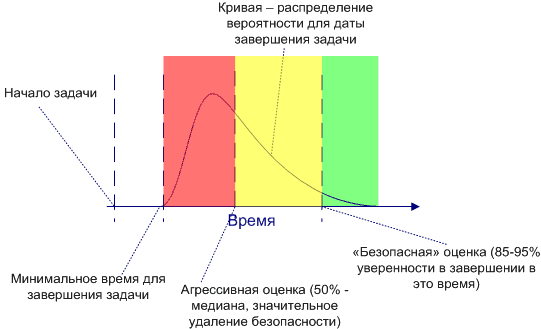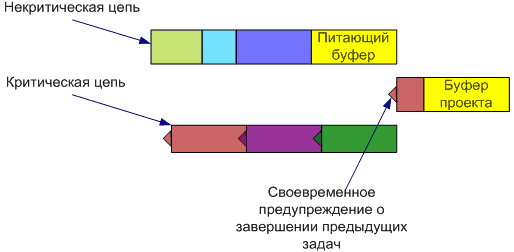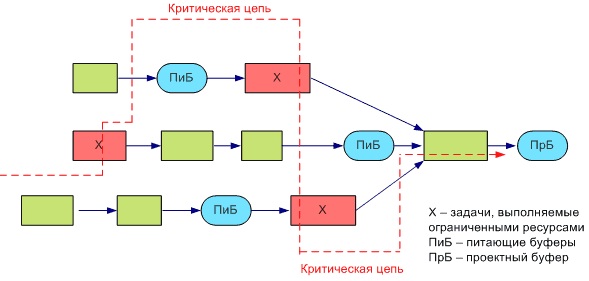Critical chain method
Critical Chain Method: Effective Project Management Using Time and Resource Buffers
Work seeks to take all the time allotted to it.
Parkinson's Law.
If some kind of trouble can happen, it happens.
Murphy's Law.
Some statistics
One of the reasons for separating project management into a separate area of knowledge is uncertainty . The way we manage the uncertainty in the project (including risks) directly affects the duration of the project and its success.
According to numerous studies by Standish Group 1 for traditional project management methods, only 44% of projects usually complete on time. On average, projects occupy 222% of the initial planned duration, 189% of the initial budget. 70% of projects reduce the initial scope of the project, 30% of projects are closed ahead of schedule.
And although recently, with the development of tools and techniques for project management, these numbers began to decrease, the overall picture suggests that we, as project managers, are doing our job poorly.
This article discusses the use of a relatively new project management method, the critical circuit method (MCC), comparing it with the traditional project management approach.
A traditional approach to managing uncertainty and risk
With the traditional approach to project management, problems associated with uncertainty (i.e., Murphy's law), Parkinson's law and the simultaneous work of employees on several tasks (for example, in several projects) are solved in the following ways.
Including risks and uncertainties in the task assessment
Often, both the employee and his manager tend to lay the uncertainties and risks that they foresee in assessing the tasks. Uncertainty, for example, can be associated with factors such as new technology, the inexperience of the performer in the field of the task, the lack of information about the task at the time of the assessment.
They try to minimize risks by adding standby time for each task. Since the task completion time is determined not by a single digit, but by the probability distribution, the task assessment in traditional project management can be graphically depicted as shown in Fig. 1.

Fig. 1. Task completion time as probability distribution
Risk assessment is included in the task assessment to minimize the impact of Murphy's Law. And although such an assessment is made by experts or executors of the assessed task (which is good and correct), time for uncertainty is often added “by eye”.
Thus, almost every task contains an additional margin of safety that exceeds the really expected time to complete this work. Often, risk assessment of a task is longer than the time it takes to complete the work.
On the part of the employee, this approach leads to the following negative trends. The “student syndrome" is manifested: when the employee sees that he has more than enough time to complete the task, he begins work later. Thus, the resources perform more urgent tasks or spend time reserve to work on the task itself, believing that all the time is allocated to work on it. And if the risks inherent in the standby time are triggered, the task is late.
Focus on scheduled start and end dates
In the traditional approach to project management, people strive to start and complete a task exactly at the scheduled time, which is contained in the plan and imposes a certain obligation on the executors.
This approach seems right at first glance, but it has significant drawbacks and does not use possible positive events in the project.
Firstly, early completion of work on a task does not lead to an approximation of the project end date. Contractors who must begin to perform dependent tasks are not able to do this, because they were busy doing other work and did not expect to begin their tasks earlier than planned. Thus, early completion of a task cannot accelerate the delay of tasks dependent on it and positively affect the success of the entire project.
Secondly, the delay of a task almost always leads to a delay in dependent tasks, because at the planning stage, all risks were embedded in the tasks themselves (see. Fig. 2).

Fig. 2. Tasks containing a significant reserve of time are planned one after another.
In the event of a time shift, a typical solution in traditional project management is the application of corrective actions when risks are triggered by cutting the scope of the project or allocating additional resources. This does not make happy either the customer or top-level managers.
Critical Chain Uncertainty and Risk Management
The critical chain method (MCC) was proposed by Eliyahu Goldratt in 1997 2 . MCC is a project planning and management method that pays more attention to limitations associated with project resources. It is based on methods and algorithms of the theory of constraints 3. This method is the opposite of the critical path or PERT methods in the sense that it does not imply a rigid sequence of tasks and hard planning. On the contrary, the schedule drawn up using the MCC contains an aligned load of resources in time, but requires task performers to be flexible by the time tasks are started and quickly switch between tasks and task chains (but not work on them at the same time), in order to keep the whole project within the planned time.
That is, the MCC proposes to focus not on achieving assessments of tasks and milestones, but on achieving the only important date - the promised completion date of the project.
The MCC introduces such a concept as a critical chain of tasks, or simply a critical chain. A critical chain is a sequence of tasks, the duration of which depends on the overall duration of the entire project.
The MCC eliminates the above-mentioned shortcomings in the planning, implementation and control of classical project management using the following approaches.
Eliminating the Effect of Parkinson's Law
Recall that Parkinson’s law states that work will take all the time allotted to it, no matter how much reserve time we would have put in it.
The work of resources on a task in traditional project management takes all the allotted time due to a combination of the following reasons: the presence of hard dates for the completion of the task and “safe” task estimates, including time reserves 4 . To address these issues, the MCC proposes the following actions:
- Create a schedule using fairly tight estimates of the duration of tasks. Most often, in the MCC the assessment with 50% risk assurance, the so-called aggressive assessment (see Fig. 1), is taken as the duration of the task.
Get rid of hard end dates for a task (but not a project). Of course, the tasks are still being evaluated and have an end date in the calendar plan. But this date is not considered as an obligation of the performers to finish work on the task precisely at the indicated time.
In a matrix organizational structure, it makes sense to give project managers sufficient power to protect project resources from the “more urgent” tasks of other projects or units.
Consider what these rules give us. Since the tasks are evaluated with 50% risk assurance in time, the requirement of the MCC to build a schedule using only the time necessary to complete the tasks is fulfilled. And since Since we removed security from task evaluations, it is no longer meaningful to consider the end dates for the completion of each task as something indispensable.
Thus, the techniques described help us get rid of Parkinson's law.Using the positive aspects of early completion of the task to achieve project success
The MCC conditionally divides resources into two categories: resources that perform critical tasks, and resources of non-critical tasks. In this context, the resources that we really need to take care of are the resources of critical tasks, because their use directly affects the duration of the project. And we want to be sure that when the task in the critical chain is completed, the resources to complete the next task of the critical path will be ready and available.
Two simple steps, performed with a certain amount of professionalism, will allow you to take advantage of early completion for tasks in the critical chain. Firstly, it is necessary to collect information from resources: for how much they need to be warned that they should interrupt their current work and switch to more important tasks of the critical chain. Secondly, to require that resources periodically provide estimates of the time required to complete their current tasks (“warning buffer”).
With this information, we can track when the estimate of the remaining time of the current task of the critical chain becomes less than the warning buffer of the executor of the dependent task, and notify the latter that he was ready to start his task soon.
Compared to traditional project management, this is a step from monitoring and reports of the “what was done” type, using the percentage of completion (which, incidentally, is quite subjective), to what should be considered valuable in terms of project status - how much is left time to complete unfinished tasks.Using time and resource buffers to prevent Murphy’s Law
Excellent, we reduced the grades to the minimum acceptable, thereby concentrating all efforts on the task. We take advantage of early task completion. But if we now have no “iron” date by which the task should be completed, how do we know when the resource will be available for other tasks? And, besides, how now to deal with risks that are now not minimized by the additional task time?
In order to protect the end date of the entire project from task variations, the MCC uses resource and time buffers.
This section describes the use of time buffers. The MCC focuses on the tasks of critical circuits. All we do is accumulate the backup time of all tasks of the chain, which ranged from 50% to 90% of the coverage of uncertainty, leaving only 50% of the coverage for the tasks themselves. These reserves, spread over all tasks, are summed up in a single time buffer, which is placed at the end of the chain (see Fig. 3). Thus, variations in the critical chain do not have a direct impact on the promised end date of the project, as they are quenched by the time buffer.
Fig. 3. A time buffer placed at the end of the circuit protects it from time delays
Since we leave only 50% of the risk coverage in the assessment of the task, we can expect that in half the cases the tasks will be completed earlier than planned, in half - later. At MCC, we are actively taking advantage of the early completion of tasks. As for delayed tasks, they will be compensated by the circuit buffer. Without going into statistics, we state that the total buffer should be significantly less than its constituent time segments from the reserves of individual tasks (by 30-50%).
As for the tasks of the non-critical chain, here we do not want to engage in micro-management for each task and executor, as is the case with critical chains, using notifications of tasks that are completed. However, we also want the tasks of the non-critical path also not to affect the success of the project.
What does the traditional approach to managing non-critical path tasks imply? Start tasks as early as possible and hope that there is enough time available for non-critical tasks to cover risks.
Unlike traditional project management, in MCC we use not only free time (float) for non-critical tasks, but also the same approach with a buffer at the end of the chain (now non-critical) that was described for critical tasks. This buffer, let's call it “supply”, protects dependent critical chains from time variations in non-critical chains.
Fig. 4 . MSC scheduling
For a non-critical chain, we do not use any additional tools in order to avoid the consequences of delayed completion of tasks (for example, a warning about an approaching work). For such tasks, we already have a double buffer: free time of a non-critical circuit (float) and a supply buffer.
Thus, MCC scheduling uses “feed” and project time buffers, as well as resource buffers (described in the next section).Using the resource buffer
A particularly interesting tool in the MCC is the use of resource buffers. We can conditionally distinguish two types of such buffers.
Firstly, the time during which we warn the performer that he will soon have a task from the critical chain is a resource buffer.
The second type of buffer is the allocation of alternative (additional) resources for critical chain tasks. This buffer makes sense when tasks can undergo frequent changes. In this case, adding resources means protecting against the risks of the final project end date.
Fig. 5. The critical chain in this case consists of tasks performed by limited resources.
In Fig. 5 shows a critical chain that is constituted by limited resources. Accordingly, the buffers used in this situation are not used to prevent a lack of time (incorrect estimates). Time resource buffers in this case are used to manage the risks associated with limited resources.
The supply buffers face the tasks of critical resources, thus protecting the tasks of the critical circuit from time shift in case of delay of tasks of non-critical circuits.Buffer as a means of monitoring and control
Project progress and planning accuracy using MCCs are often tracked not by the classic earned value analysis technique, but by the percentage of buffers used. Those. the more time planned as a buffer is used, the greater the influence of uncertainty on the project in the form of realized rice. Tracking the remaining time buffers for the task is used in the MCC to monitor the status of the task: when the minimum threshold threshold value is reached, corrective actions must be taken. Similarly, the percentage of use of the project buffer serves as both a trigger for determining the feasibility of the promised completion date and an indicator of project success (for example, if you used no more than 50% of the project time buffer, the project should be considered very successful).Practical steps for using MCC
Summarizing everything described, we can recommend the following set of practical steps for using the MCC:- Explain to implementers that they must protect their assessments from pressure from superiors and other project stakeholders.
As an estimate of the duration of tasks, take estimates with a 50% coverage of uncertainty.
Eliminate competition for resources by balancing the load. It will also remove the need to switch resources between tasks. The critical chain can now be defined as the longest chain of path and resource dependency.
Insert the project buffer at the end of the project to accumulate backup time (initially - approximately 50% of the critical chain path length).
Protect critical circuits from inaccessible resources using resource buffers.
Calculate and arrange supply buffers for all paths on which critical circuits depend.
Plan tasks that do not depend on any other tasks, from the end date of the project to its beginning. This will be an additional assurance of lack of multitasking resources.
Track and achieve planned resource performance. Performers should work on tasks as quickly as possible and give back the result of their work as soon as it is completed.
Provide resources with information about the duration and estimated time of the start of the task, but not about the milestones of the project. This should force resources to give results of their work as soon as it is finished.
At the stage of the project, the allocated time and resource buffers are actively managed in order to minimize delays in the execution of tasks, but to keep realistic one of the main promises of the project - the date of its completion.
Thus, the MCC helps to avoid the effect of the Parkinson law and, at the same time, protect itself from Murphy's law. The considered method focuses the attention of the project manager on team performance, offers a new method for tracking project progress based on the use of time and resource buffers. MCC can be applied in almost any field where the project management methodology is applied, and does not require significant restructuring of the processes in the project.
1 http://www.pqa.net/ProdServices/ccpm/W05002001.html
2 Eliyahu M. Goldratt. Critical chain. (1997) ISBN 0-88427-153-6.
3 http://en.wikipedia.org/wiki/Theory_of_constraints
4 http://www.focusedperformance.com/articles/ccpm.html
© Oleg Klimenko
Taken from here
- Explain to implementers that they must protect their assessments from pressure from superiors and other project stakeholders.
